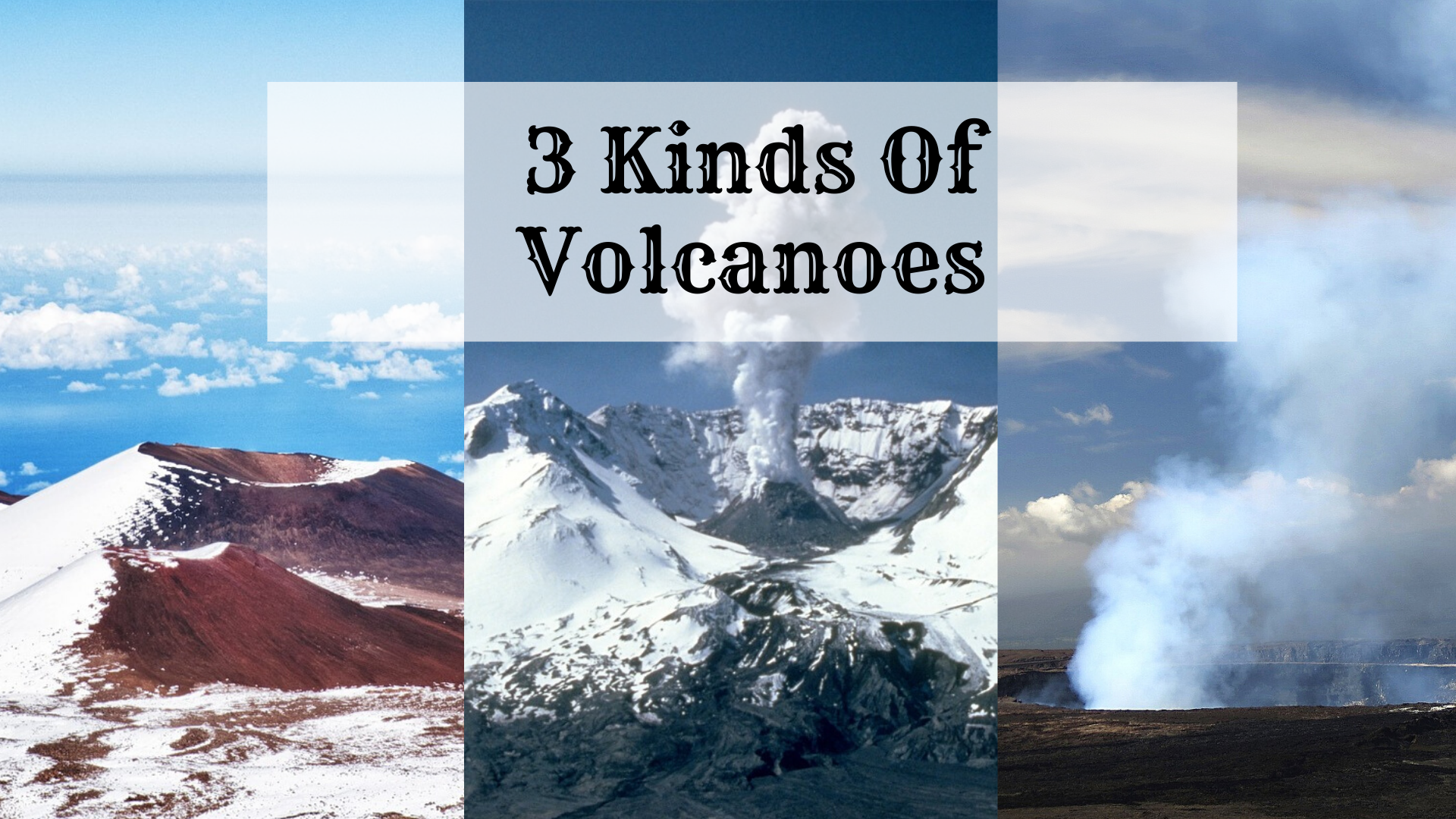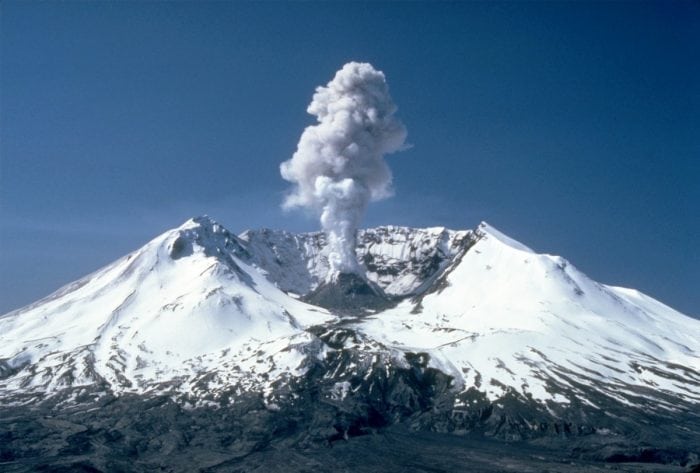
The 3 types of volcanoes are stratovolcano (also known as a composite volcano), cinder cone volcano, and shield volcano. Each one is different in its own right and provides unique clues to the geologic history of the region and information about how the volcano formed and what we can expect in the future.
Volcanoes have been around since the beginning of Earth, some 4.54 billion years ago. Through that time volcanoes were constantly being born, dying, and eroding down into low-lying lakes and oceans. Geologists study the life cycle of volcanoes in the past to get a sense of how volcanoes today will behave and hopefully predict better the onset of a volcanic eruption. To do this, however, we must know the three types of volcanoes and what makes them tick.
All civilization has from time to time become a thin crust over a volcano of revolution. – Havelock Ellis
What Is A Volcano?
A volcano is a surface expression of the Earth transferring molten rock or magma from beneath the rust to above the Earth’s crust (lithosphere). Unlike mountains, volcanoes contain conduits through vents, chimneys, and magma chambers, that move magma upward.
A volcano can exist from a number of different situations from hot spots such as the Hawaiian islands to subduction zones that formed Mount St Helens. These are surface expressions of interactions between Earth’s plates and the below lying upper mantle. Convection in the upper mantle and movement of lithospheric and oceanic plates can produce situations in which the molten rock in the upper mantle is able to breach the surface of the Earth and be released as lava.
Characteristics Of A Volcano
You will notice that some volcanoes are constantly erupting lava such as the main island of Hawaii and others build up over decades, centuries, or millennia until erupting. This is largely due to the confining stress and rate of magma chamber filling.
You can imagine that if there is a “leaky” system and you’re constantly filling that system with magma you will see continuous outflow. This is the case in Hawaii where the magma chamber has reached near the surface and there is little confining pressure to limit an eruption or prolong one.
On the other hand, you can have situations such as Mount St. Helens where the magma chamber is overlain with thousands of feet of rock. This will require the magma chamber to build up sufficient pressure to equal and then surpass the overburden pressure. At that point the volcano will erupt in a spectacular fashion, sending the overburden rock, ash, and lava high into the air.
“A volcano is an independent machine… being engaged in its own peculiar business, cooking as it were its special dish, which in due time is to be separately served … pouring out totally different kinds of lava.” — Clarence Dutton
But wait, we’re missing one key component. That is a gas composition within the magma itself.
You will notice that some volcanoes produce liquid like lava that pours down the side of the volcano whereas others explosively erupt sending rock, ash, and lava high into the air. As mentioned before, this is partially due to the overburden pressure required to erupt but also partially due to the presence of gas within the magma.
Imagine if you have a significant amount of gas such as CO2 within the magma. When confined in the magma chamber that gas is in solution and significantly compressed compared to the volume at the surface. As the volcano erupts, the pressure on those gases dramatically decreases which means the volume rapidly increases. This chain reaction acts to explosively expand the gas and causes overlying rock and magma to be ejected high into the atmosphere.
On the other hand, lava such as that at Arenal volcano or Hawaii erupts with little gas, meaning the magma simply runs down the slope of the volcano.
Where Do Volcanoes Form?
Volcanoes form often times at boundaries of plates (convergent or divergent) or hot spots.
- Hot Spot: Hawaiian Islands, Yellowstone Supervolcano
- Divergent plate boundaries: Mid-ocean ridges, rifts
- Convergent plate boundaries: Subduction zones
In the case of hot spots, they can occur anywhere in the world regardless of being nearby a plate boundary. Hot spots are not well understood but the basic premise is that you have upwelling magma in a stationary location, which acts to eventually melt through Earth’s crust and form a volcano. Imagine a blow torch over a piece of bread and, eventually, the blow torch burns through the bread and “erupts” onto the surface.
Divergent Plate BoundaryDivergent plate boundaries are responsible for the opening up of the Atlantic ocean and are associated with plates being pulled or pushed apart. This thins the crust and allows for magma to erupt in the center of the diverging plates. It’s still unclear whether the plates are pulled or pushed apart, but in either situation, this creates a localized ridge of thinner crust and less overburden for the magma to come to the surface.
Convergent plate boundaryThe last place volcanoes typically form are convergent plate boundaries. This is similar to what we see on the northwest coast of the United States, the Andes Mountains, and Japan. In fact, the ring of fire along the Pacific Ocean is due to the subduction of the oceanic crust underneath the continental crust through converging plates.
Volcanoes situated along the Ring of FireAs one plate subducts underneath the other it gets heated and begins to melt, along with rock that holds water within its structure. This water turns to steam, further reduces the melting temperature of the rock and the now buoyant molten rock migrates upward to the surface creating a volcano.
3 Types Of Volcanoes
Now that we have a good fundamental background on what volcanoes are, let’s dive into the three major types of volcanoes. We will discuss the key differences in the volcanoes and examples that you have likely heard of.
| Volcano Type | Volcano Shape | Size | Volcanic Material | Eruption Style | Example Volcano |
|
Cinder Cone |
Steep conical hill with 30- to 40-degree slopes |
Small, less than 300m tall |
cinders |
Explosive |
Paricutin |
|
Shield Volcano |
Very gentle slopes with a broad base |
Large, many 10’s of kilometers across |
fluid lava flows, typically mafic (basalt) |
Quiet |
Mauna Loa |
|
Stratovolcano |
Goes from gentle to steep slopes from base to peak |
Large, up to 10 km across |
many layers of lava and pyroclastics |
Explosive |
Mount St. Helens |
Stratovolcano (Composite Volcano)
A stratovolcano, sometimes referred to as a composite volcano, is an explosive volcano that has built up several layers through continuous eruptions. The volcano is typically conical and large in scale compared to cinder cone volcanoes.

Image by Pxhere is licensed under CC0
The layers are made up of lithified lava, pumice and volcanic ash that have fallen on the volcano during an eruption. Typically, eruptions are explosive with high gas concentrations and significant overburden. Stratovolcanoes are also characterized by steep sides, especially compared to a shield volcano.
Most of the time the magma in stratovolcanoes are felsic and have high concentrations of silica. We see stratovolcanoes all around the world and on other planets such as Mars. These volcanoes are typically thought of when we picture devastating eruptions since they often contain significant gas and erupt spectacularly.
A famous stratovolcano, Mount St. Helens, erupted in 1980 with a plume that extended 3,000 feet above the volcano. These volcanoes are associated with subduction zones typically, as seen along the Pacific Ring of Fire. Other well known stratovolcanoes are Krakatoa, Vesuvius, and Mount Tambora; all of which had major eruptions that killed thousands of people and altered climate on a continental scale. Mount Tambora is responsible for the most powerful volcanic eruption on record, which sent ash plumes around the world dimming the sun and reducing global temperatures by 3.5°C.
Cinder Cone Volcano
A cinder cone volcano, sometimes referred to as a scoria cone, is a small steep sided conical volcano. It is often fairly small with loose volcanic fragments such as ash, scoria, or cinder that has fallen down the sides of the volcano.

“Mauna Kea cinder cone” by the USGS, linked from NASA web page and Wikimedia Commons, is licensed under CC0
They are associated with volcanic vents that erupt and send small fragments of solidified magma into the air that rain down the slopes of the volcano. This produces a very steep-sided mountain between 30 and 40 degrees and almost perfectly canonical with a circular base. You can often find cinder cone volcanoes associated with the other two types of volcanoes, shield and stratovolcano. Typically eruptions are not significant and happen much more frequently.
“A volcano may be considered as a cannon of immense size.” — Oliver Goldsmith
Shield Volcano
Shield volcanoes are typically large mafic volcanoes that have wide broad and low relief slopes. The lava erupted from a shield volcano is typically runny and low in gas so the lava simply flows down the side of the volcano during an eruption. Think of lava you’ve seen flowing off the edge of the big island of Hawaii and into the ocean.

“Sierra Grande Shield Volcano (Raton-Clayton Volcanic Field, northeastern New Mexico, USA)” by James St. John via Flickr is licensed under CC BY 2.0.
This almost constant low viscosity lava over time builds up broad sheets of lithified lava to create a shield-shaped volcano. The low viscosity is due to the mineralogy of the lava and is typically mafic in nature. You won’t see large eruptions where lava is ejected high into the air, but the lava can be fast flowing down the slopes, enveloping houses and cars on its way down. Since the lava is runny it can flow for miles from the original source and someone who may think they are safe due to distance from the volcano could see lava at their doorstep.
Shield volcanoes are typical of hot spots, such as the Hawaiian island chain. In fact, if you take the base of Mauna Loa, which is the shield volcano that makes up the big island of Hawaii, it is the tallest mountain in the world from base to peak. However, much of the volcano is under tens of thousands of feet of water. These volcanoes can also be hundreds of miles wide at the base.
That wraps up the 3 major types of volcanoes and gives you a good basis for understanding more about the background of volcanoes. Volcanic eruptions are something humans need to manage globally, albeit, we are learning to become more predictive and better at managing the risk of an eventual eruption.
“Volcanoes are one way earth gives birth to itself.” — Robert Gross









